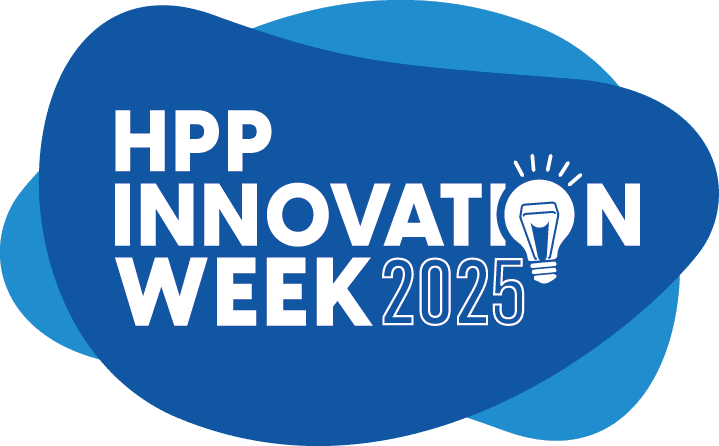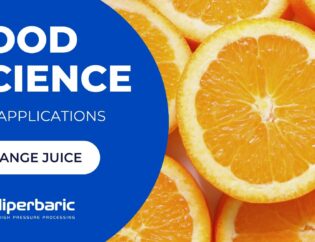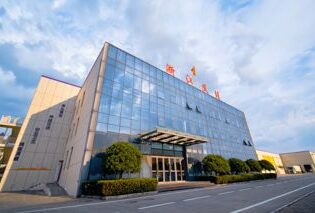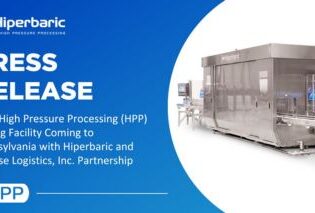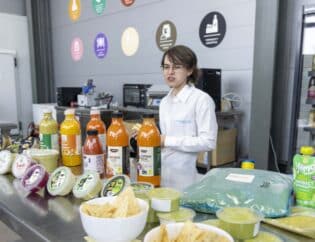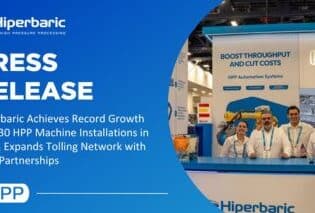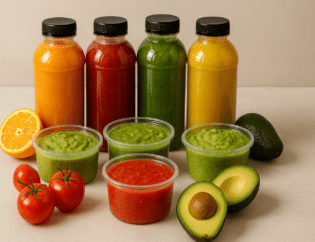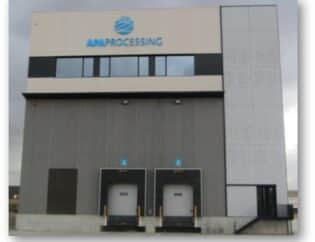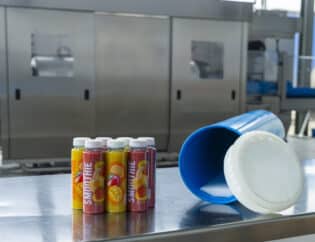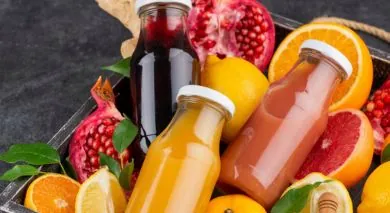
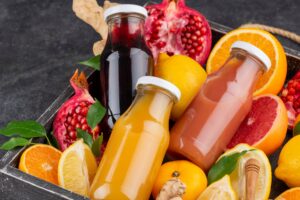
The cold-pressed juice industry is turning to nonthermal processing technologies to ensure safety and freshness without compromising quality. This blog post explores four major alternatives: High Pressure Processing (HPP), Ultraviolet Light (UV-C), Microfiltration (MF), and Non-Thermal Plasma (NTP); highlighting how each method works, its benefits, limitations, and current implementation status based on Technology Readiness Levels (TRLs). While HPP stands out as the most commercially mature (TRL 9), other technologies like UV-C and MF offer energy-efficient and complementary options. NTP, though still emerging, shows promise for the future of juice sterilization. Learn how these innovations are shaping juice preservation today.
The natural cold-pressed juice industry is constantly evolving, searching for gentle methods that ensure food safety without compromising the freshness of its raw materials. Nonthermal processing technologies have emerged as powerful tools to meet this demand.
Understanding the maturity of each nonthermal technology is key to making informed investment and production decisions. This is what the Technology Readiness Level (TRL) framework tries to evaluate how close technology is to widespread industry use ranging from TRL 1 (basic research) to TRL 9 (full commercial implementation; Figure 1). In this post, we’ll explore the state of the art of the currently available nonthermal technologies for juice processing.
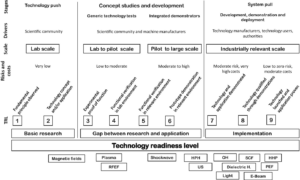
1. High Pressure Processing (HPP): The Benchmark in Nonthermal Preservation
High Pressure Processing (HPP) is a nonthermal preservation method that subjects pre-packaged juices (In-Pack) to extremely high hydrostatic pressures, up to 600 MPa (87,000 psi), uniformly and instantaneously. This pressure disrupts the cellular membranes of pathogens and spoilage microorganisms without the need for heat, making it highly effective for food safety while preserving product quality (Waghmare, 2024).
HPP stands out as the most commercially mature nonthermal technology. It delivers great microbial reductions with a resulting longer life. HPP can process a wide range of juice viscosities and particle sizes, which means it is not limited by physical characteristics of the juice (Stinco et al., 2019).
Despite its benefits, HPP involves high investment capital, and traditionally operates in batch mode, which may limit throughput for some producers (Augusto et al., 2018). It also requires plastic packaging, although Hiperbaric’s In-Bulk technology offers an alternative that eliminates this limitation by processing juice before packaging.
Finally, HPP is widely adopted in the cold-pressed juice industry and has been extensively validated for pathogen inactivation, shelf-life extension, and nutrient preservation (TRL-9). Its effectiveness has made it a preferred choice for premium juice brands seeking clean-label solutions without preservatives.
2. Ultraviolet Light (UV) for Effective Pasteurization
Ultraviolet (UV-C) pasteurization is a nonthermal method that uses ultraviolet light, typically at a wavelength of 254 nm, to inactivate microorganisms in liquid foods. It works by damaging the DNA and RNA of bacteria, viruses, and yeasts, preventing their reproduction. This is achieved without raising the temperature of the product, preserving its raw characteristics (Baysal, 2018).
UV-C is energy-efficient, requires a relatively low investment, and supports continuous-flow processing, making it suitable for large-scale operations. It is well developed and closer to commercial readiness, with proven use in various food and beverage applications.
One of the main limitations of UV-C is its dependency on the optical properties of the juice. It is most effective with clear or low-turbidity juices, as suspended particles and color compounds can block or scatter the light, reducing efficacy. Uniform exposure is also critical, often requiring specially designed reactors to ensure all fluid particles are irradiated. Another important aspect is to ensure aseptic post-treatment packaging (Koutchma, 2019a).
UV-C technology is currently applied in the commercial processing of clear beverages like apple juices, apple cider and lemonades, where light penetration is sufficient. Studies have shown that with optimized flow systems, it can effectively reduce microbial loads while preserving sensory and nutritional quality. Regulatory acceptance has supported its gradual adoption (TRL-8), particularly in facilities looking for low energy, nonthermal alternatives to traditional pasteurization (Koutchma, 2019b).
3. Microfiltration (MF): Clean Juice Through Physical Filtration
Membrane microfiltration (MF) is a nonthermal technique that uses porous membranes, typically with pore sizes between 0.1 and 10 micrometers, to physically remove microorganisms, yeasts, molds, and suspended solids from juices. The process relies on size exclusion rather than chemical or thermal mechanisms, and it operates under low pressure to preserve the juice’s original properties.
MF is a gentle, energy-efficient, and relatively low-cost option. It is especially beneficial for juice clarification, improving visual appeal by removing turbidity (Satyannarayana et al., 2023). Unlike UV-C, efficiency of MF is unaffected by juice color or opacity, and it can serve as a complementary pre-treatment to enhance the effectiveness of other preservation methods.
Microfiltration does not inactivate pathogens, it merely removes them, so its ability to ensure food safety on its own is limited as membrane integrity must be maintained at all times. The membranes are also prone to fouling, which can reduce filtration efficiency and require regular cleaning or replacement. It is less effective for juices with high pulp content, as particulates can clog the membrane and interfere with flow rates. Even more some juice constituents are removed, which affects nutrition quality (Prades et al., 2012). Like UV-C, it requires aseptic packaging measures.
MF is commonly used in the juice industry for clarification and partial microbial reduction (TRL 8), particularly in apple, grape, coconut water, and citrus juices. When combined with other nonthermal technologies, it helps reduce microbial load and extends shelf life without compromising flavor or nutrition. Its modular nature allows for flexible integration into existing processing lines, especially in facilities focused on premium or “cold-crafted” juice products.
4. Non-Thermal Plasma (NTP): Innovative Juice Sterilization on the Horizon
Non-Thermal Plasma (NTP), also known as cold plasma, is an emerging food processing technology that uses electrical discharges at atmospheric or low pressure to generate a mix of reactive oxygen and nitrogen species. These reactive particles can inactivate a broad range of microorganisms without the need for heat, preserving the sensory and nutritional qualities of foods (Dzimitrowicz et al., 2025).
NTP has the potential for continuous processing with a high antimicrobial spectrum. Especially, has shown promising results for decontamination of fresh produce (whole fruits and vegetables), but there is some insights for shelf life extension by microbial decontamination of food products including fruit juices, food packaging materials, equipment cleaning, and biofilm control. It operates at ambient temperatures, making it particularly gentle on juice flavor and nutrients (Pankaj & Keener, 2018).
Despite its promise, NTP is still in the early stages of development for juice applications. It currently faces challenges in process standardization, scale-up, and regulatory approval (TRL 4). Its effects on complex juice matrices and bioactive compounds are still under study, and equipment scalability for high-throughput production remains limited. Though promising, especially for surface sterilization and emerging liquid applications, it requires further research and validation before reaching commercial readiness (Waghmare, 2021).
Comparative Summary of Nonthermal Technologies for Juice Processing
Non-thermal technologies are transforming the way we process juices, providing a safe option that does not compromise on quality. The next table presents a summary of the unique advantages and limitations of each technology, which meets the highest standards for natural, safe and fresh juice products.
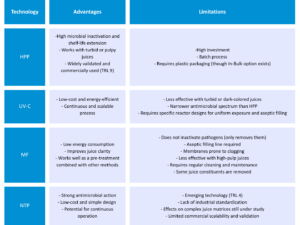
As shown in this summary table, HPP is the most advanced nonthermal technology. It is fully commercialized, widely adopted across the cold-pressed juice sector, and supported by robust equipment solutions. To dive deeper into this innovative technology, you can visit our High Pressure Processing (HPP) page, or you can contact us directly.

